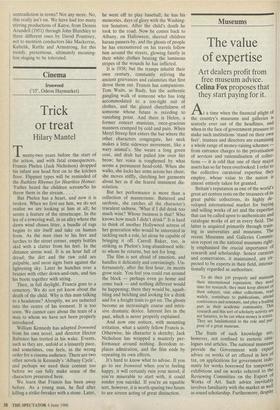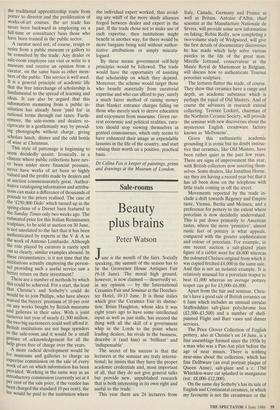Museums
The value of expertise
At a time when the financial plight of the country's museums and galleries is scarcely ever out of the headlines, and when in the face of government pressure to make such institutions 'stand on their own feet', trustees and directors are examining a whole range of money-raising schemes — from entrance charges to the privatisation of services and rationalisation of collec- tions — it is odd that one of their major assets has so far been overlooked: I refer to the collective curatorial expertise theY employ, whose value to the nation is almost entirely taken for granted. Britain's reputation as one of the world's great art centres rests on the treasures of its great public collections, its highly de- veloped international market for buying and selling works of art and the expertise that can be called upon to authenticate and catalogue works of art in every field. The latter is acquired primarily through train- ing in universities and museums. The recent Museums and Galleries Commis- sion report on the national museums right- ly emphasised the crucial importance of research and scholarship. Senior curators and conservators, it maintained, are ex- pected to be experts in their field, interna- tionally regarded as authorities: To do their job properly and maintain their international reputation, they need time for research; they must keep abreast of their subject, visit other collections, read widely, contribute to publications, attend conferences and seminars, and play a leading part in their academic community. This research and this sort of scholarly activity are not luxuries, to be cut when money is scarce. They are fundamental to the role and pur- pose of a great museum.
The fruits of such knowledge are, however, not confined to esoteric cata- logues and articles. The national museums provide the Government with expert advice on works of art offered in lieu of tax, on applications for government inde- mnity for works borrowed for temporarY exhibitions and on works referred to the Reviewing Committee on the Export of Works of Art. Such advice inevitablY involves familiarity with the market as well as sound scholarship. Furthermore, despite the traditional apprenticeship route from porter to director and the proliferation of works-of-art courses, the art trade has never been backward in employing on a full-time or consultancy basis those who have been trained in the public sector.
A curator need not, of course, resign or retire from a public museum or gallery to be consulted by the trade. Any dealer or sale-room employee can visit or write to a museum and receive an opinion from a curator, on the same basis as other mem- bers of the public. This service is well used. It is a general principle of academic life that the free interchange of scholarship is fundamental to the spread of learning and ideas. It can also be argued that this information stemming from a public in- stitution has already been 'paid for' in national terms through our taxes. Furth- ermore, the sale-rooms and dealers re- ciprocate in a gentlemanly way by provid- ing photographs without charge, giving scholars lunch, dinner and the odd bottle of wine at Christmas.
This style of patronage is beginning to seem decidedly quaint. Ironically, in a Climate where public collections have nev- er been under more financial pressure, never have works of art been so highly valued and the profits made by dealers and at auction commensurately great. Author- itative cataloguing information and attribu- tions can make a difference of thousands of Pounds to the prices realised. The case of the 1250,000 Dido' which turned up in the spring-clean of a Dorset barn featured in the Sunday Times only two weeks ago. The estimated price for this Italian Renaissance Sculpture, to be sold at auction on 30 June, is not unrelated to the fact that it has been authenticated by experts at the V & A as the work of Antonio Lombardo. Although the role played by curators is rarely spelt out so clearly, similar examples abound. In these circumstances, is it not time that the Institutions actually employing the person- nel providing such a useful service saw a better return on their investment?
There are a number of methods by which this could be achieved. For a start, the least that Christie's and Sotheby's could do would be to join Phillips, who have always waived the buyers' premium of 10 per cent on any works bought by British museums and galleries in their sales. With a joint turnover last year of nearly £1,500 million, the two big auctioneers could well afford it. R. ritish institutions are not huge spenders in the sale-room and it would be a small gesture of acknowledgement for all the help given free of charge over the years. A more radical development would be for museums and galleries to charge an expertise commission on the sale of every work of art on which information has been Provided. Working in the same way as an introductory commission (currently set at 4 Per cent of the sale price, if the vendor has been charged the standard 10 per cent), the fee would be paid to the institution where the individual expert worked, thus avoid- ing any whiff of the more shady alliances forged between dealer and expert in the past. If the trade chose not to make use of such expertise, then institutions might benefit in another way, for there would be more bargains being sold without author- itative attributions or simply miscata- logued.
By these means government self-help principles would be followed. The trade would have the opportunity of assisting that scholarship on which they depend. Moreover, the scheme would target those who benefit materially from curatorial expertise and who can afford to pay, surely a much fairer method of raising money than blanket entrance charges falling on those who merely seek to derive education and enjoyment from museums. Given cur- rent economic and political realities, cura- tors should stop viewing themselves as genteel connoisseurs, which only seems to have enhanced their image as expendable luxuries in the life of the country, and start valuing their worth on a positive, practical basis.
Dr Celina Fox is keeper of paintings, prints and drawings at the Museum of London.



















































 Previous page
Previous page